Business in Practice: Structures, PESTLE Analysis, Performance
VerifiedAdded on 2023/01/04
|14
|2690
|51
Report
AI Summary
This report delves into the intricacies of various business structures, including micro, small, medium, and large businesses, as well as sole trader, partnership, limited liability, public limited liability, and cooperative models. It defines their characteristics and provides examples. The report then examines organizational structures like functional, hierarchical, and matrix structures and their impact on business productivity. Furthermore, it utilizes PESTLE analysis to explain how political, economic, social, technological, environmental, and legal factors affect business performance, using Coca-Cola as a case study. The report concludes by summarizing the key findings and emphasizing the importance of understanding different business structures and external factors for business success. The report is contributed by a student to be published on the website Desklib.
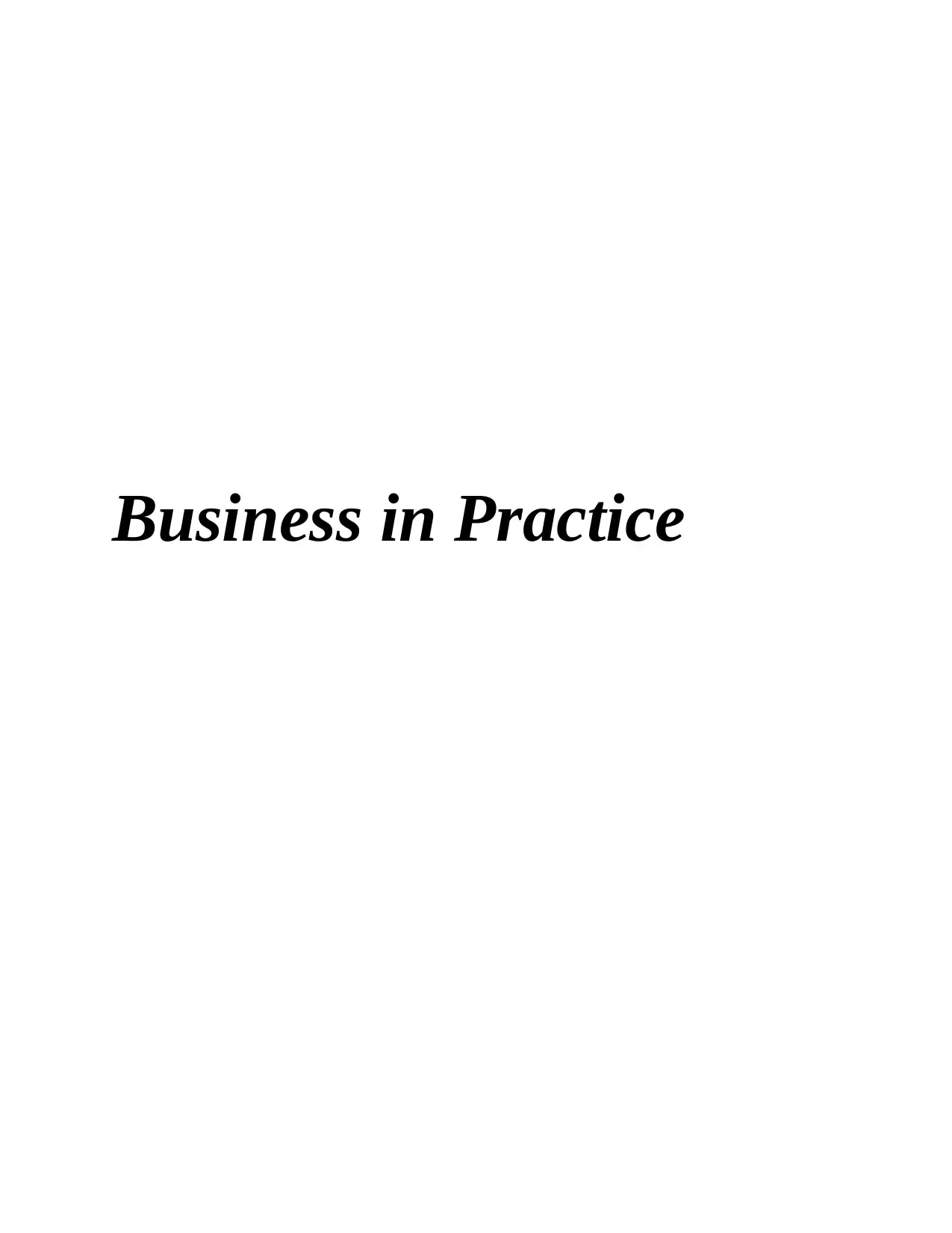
Business in Practice
Paraphrase This Document
Need a fresh take? Get an instant paraphrase of this document with our AI Paraphraser
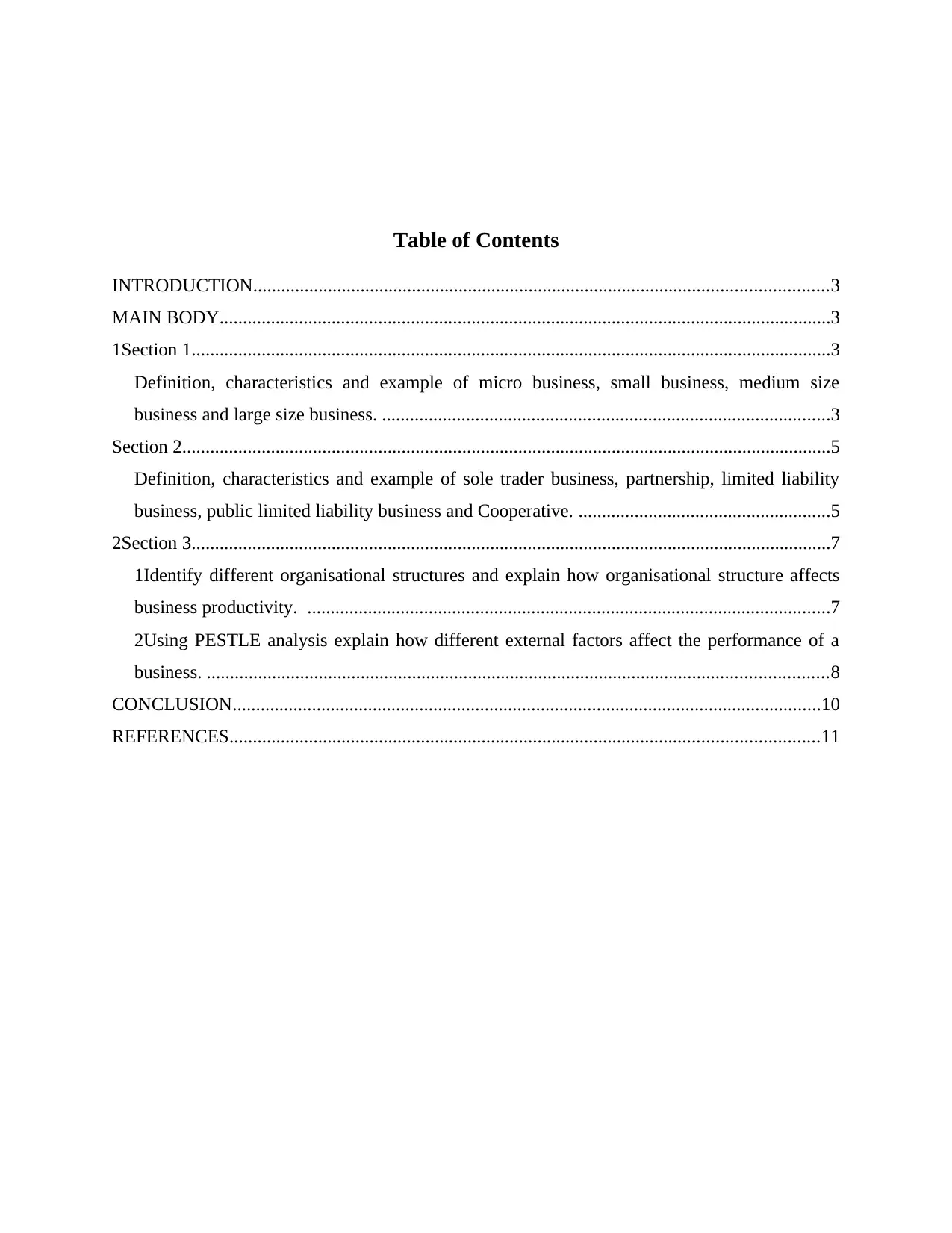
Table of Contents
INTRODUCTION...........................................................................................................................3
MAIN BODY...................................................................................................................................3
1Section 1.........................................................................................................................................3
Definition, characteristics and example of micro business, small business, medium size
business and large size business. ................................................................................................3
Section 2...........................................................................................................................................5
Definition, characteristics and example of sole trader business, partnership, limited liability
business, public limited liability business and Cooperative. ......................................................5
2Section 3.........................................................................................................................................7
1Identify different organisational structures and explain how organisational structure affects
business productivity. ................................................................................................................7
2Using PESTLE analysis explain how different external factors affect the performance of a
business. .....................................................................................................................................8
CONCLUSION..............................................................................................................................10
REFERENCES..............................................................................................................................11
INTRODUCTION...........................................................................................................................3
MAIN BODY...................................................................................................................................3
1Section 1.........................................................................................................................................3
Definition, characteristics and example of micro business, small business, medium size
business and large size business. ................................................................................................3
Section 2...........................................................................................................................................5
Definition, characteristics and example of sole trader business, partnership, limited liability
business, public limited liability business and Cooperative. ......................................................5
2Section 3.........................................................................................................................................7
1Identify different organisational structures and explain how organisational structure affects
business productivity. ................................................................................................................7
2Using PESTLE analysis explain how different external factors affect the performance of a
business. .....................................................................................................................................8
CONCLUSION..............................................................................................................................10
REFERENCES..............................................................................................................................11
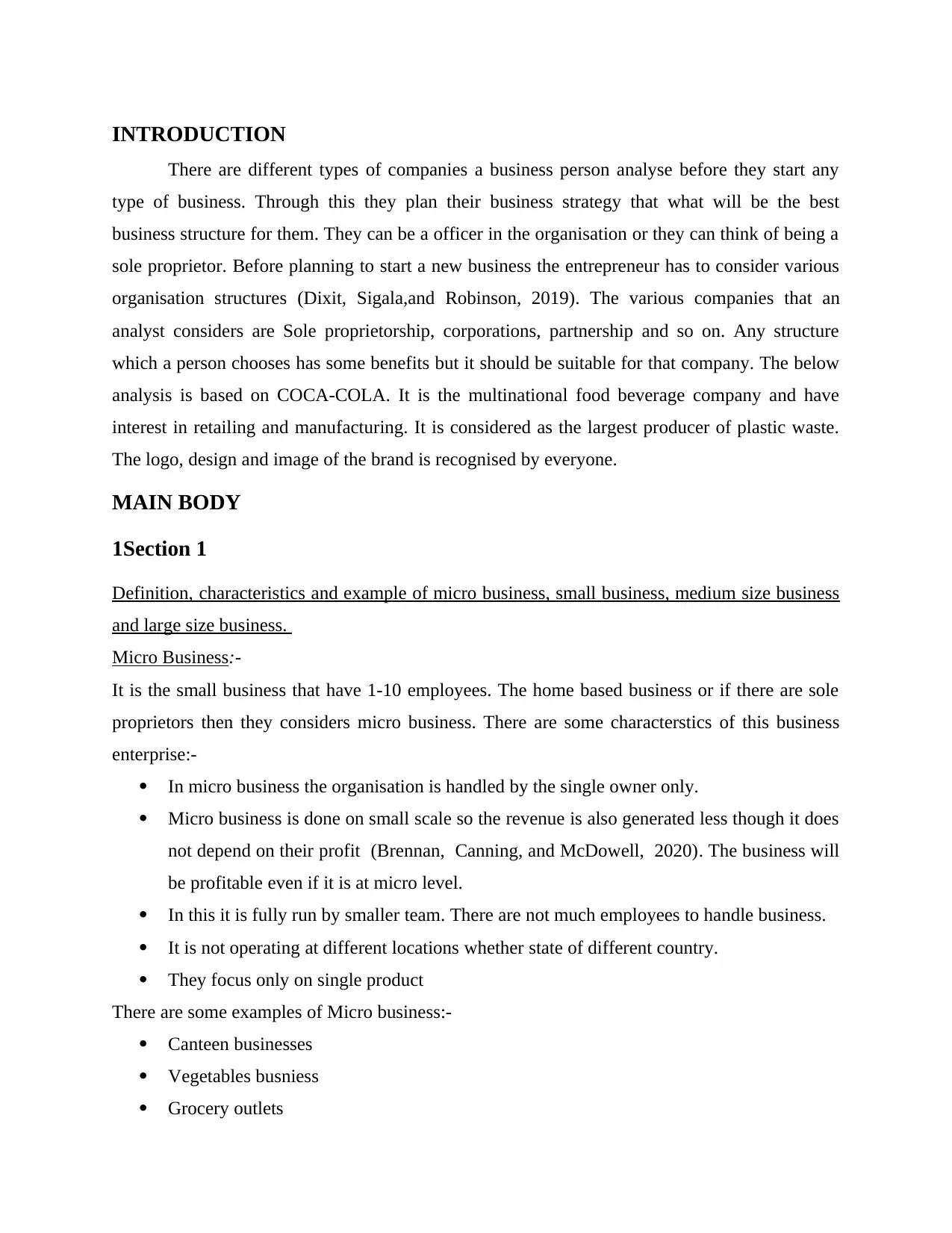
INTRODUCTION
There are different types of companies a business person analyse before they start any
type of business. Through this they plan their business strategy that what will be the best
business structure for them. They can be a officer in the organisation or they can think of being a
sole proprietor. Before planning to start a new business the entrepreneur has to consider various
organisation structures (Dixit, Sigala,and Robinson, 2019). The various companies that an
analyst considers are Sole proprietorship, corporations, partnership and so on. Any structure
which a person chooses has some benefits but it should be suitable for that company. The below
analysis is based on COCA-COLA. It is the multinational food beverage company and have
interest in retailing and manufacturing. It is considered as the largest producer of plastic waste.
The logo, design and image of the brand is recognised by everyone.
MAIN BODY
1Section 1
Definition, characteristics and example of micro business, small business, medium size business
and large size business.
Micro Business:-
It is the small business that have 1-10 employees. The home based business or if there are sole
proprietors then they considers micro business. There are some characterstics of this business
enterprise:-
In micro business the organisation is handled by the single owner only.
Micro business is done on small scale so the revenue is also generated less though it does
not depend on their profit (Brennan, Canning, and McDowell, 2020). The business will
be profitable even if it is at micro level.
In this it is fully run by smaller team. There are not much employees to handle business.
It is not operating at different locations whether state of different country.
They focus only on single product
There are some examples of Micro business:-
Canteen businesses
Vegetables busniess
Grocery outlets
There are different types of companies a business person analyse before they start any
type of business. Through this they plan their business strategy that what will be the best
business structure for them. They can be a officer in the organisation or they can think of being a
sole proprietor. Before planning to start a new business the entrepreneur has to consider various
organisation structures (Dixit, Sigala,and Robinson, 2019). The various companies that an
analyst considers are Sole proprietorship, corporations, partnership and so on. Any structure
which a person chooses has some benefits but it should be suitable for that company. The below
analysis is based on COCA-COLA. It is the multinational food beverage company and have
interest in retailing and manufacturing. It is considered as the largest producer of plastic waste.
The logo, design and image of the brand is recognised by everyone.
MAIN BODY
1Section 1
Definition, characteristics and example of micro business, small business, medium size business
and large size business.
Micro Business:-
It is the small business that have 1-10 employees. The home based business or if there are sole
proprietors then they considers micro business. There are some characterstics of this business
enterprise:-
In micro business the organisation is handled by the single owner only.
Micro business is done on small scale so the revenue is also generated less though it does
not depend on their profit (Brennan, Canning, and McDowell, 2020). The business will
be profitable even if it is at micro level.
In this it is fully run by smaller team. There are not much employees to handle business.
It is not operating at different locations whether state of different country.
They focus only on single product
There are some examples of Micro business:-
Canteen businesses
Vegetables busniess
Grocery outlets
⊘ This is a preview!⊘
Do you want full access?
Subscribe today to unlock all pages.

Trusted by 1+ million students worldwide
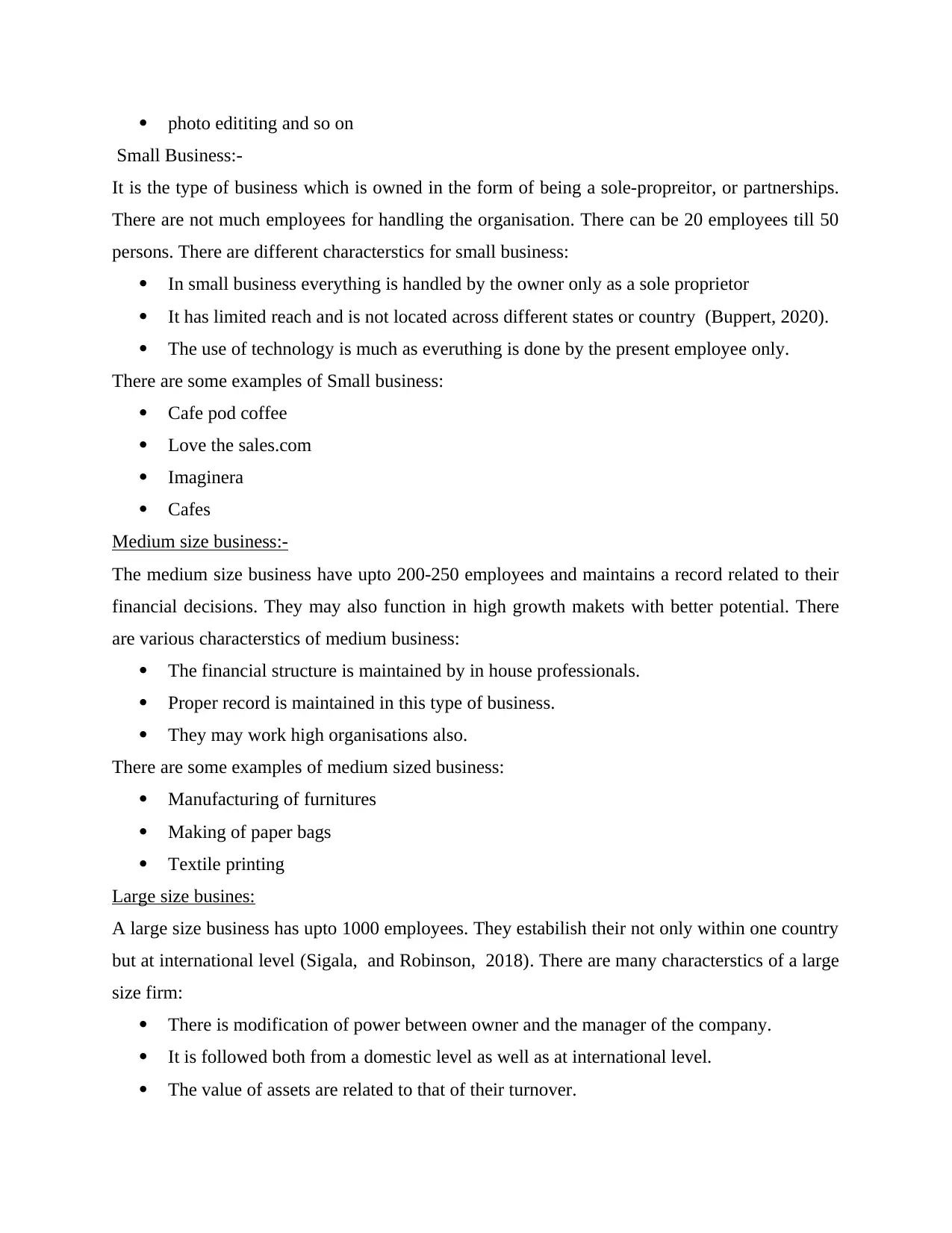
photo edititing and so on
Small Business:-
It is the type of business which is owned in the form of being a sole-propreitor, or partnerships.
There are not much employees for handling the organisation. There can be 20 employees till 50
persons. There are different characterstics for small business:
In small business everything is handled by the owner only as a sole proprietor
It has limited reach and is not located across different states or country (Buppert, 2020).
The use of technology is much as everuthing is done by the present employee only.
There are some examples of Small business:
Cafe pod coffee
Love the sales.com
Imaginera
Cafes
Medium size business:-
The medium size business have upto 200-250 employees and maintains a record related to their
financial decisions. They may also function in high growth makets with better potential. There
are various characterstics of medium business:
The financial structure is maintained by in house professionals.
Proper record is maintained in this type of business.
They may work high organisations also.
There are some examples of medium sized business:
Manufacturing of furnitures
Making of paper bags
Textile printing
Large size busines:
A large size business has upto 1000 employees. They estabilish their not only within one country
but at international level (Sigala, and Robinson, 2018). There are many characterstics of a large
size firm:
There is modification of power between owner and the manager of the company.
It is followed both from a domestic level as well as at international level.
The value of assets are related to that of their turnover.
Small Business:-
It is the type of business which is owned in the form of being a sole-propreitor, or partnerships.
There are not much employees for handling the organisation. There can be 20 employees till 50
persons. There are different characterstics for small business:
In small business everything is handled by the owner only as a sole proprietor
It has limited reach and is not located across different states or country (Buppert, 2020).
The use of technology is much as everuthing is done by the present employee only.
There are some examples of Small business:
Cafe pod coffee
Love the sales.com
Imaginera
Cafes
Medium size business:-
The medium size business have upto 200-250 employees and maintains a record related to their
financial decisions. They may also function in high growth makets with better potential. There
are various characterstics of medium business:
The financial structure is maintained by in house professionals.
Proper record is maintained in this type of business.
They may work high organisations also.
There are some examples of medium sized business:
Manufacturing of furnitures
Making of paper bags
Textile printing
Large size busines:
A large size business has upto 1000 employees. They estabilish their not only within one country
but at international level (Sigala, and Robinson, 2018). There are many characterstics of a large
size firm:
There is modification of power between owner and the manager of the company.
It is followed both from a domestic level as well as at international level.
The value of assets are related to that of their turnover.
Paraphrase This Document
Need a fresh take? Get an instant paraphrase of this document with our AI Paraphraser
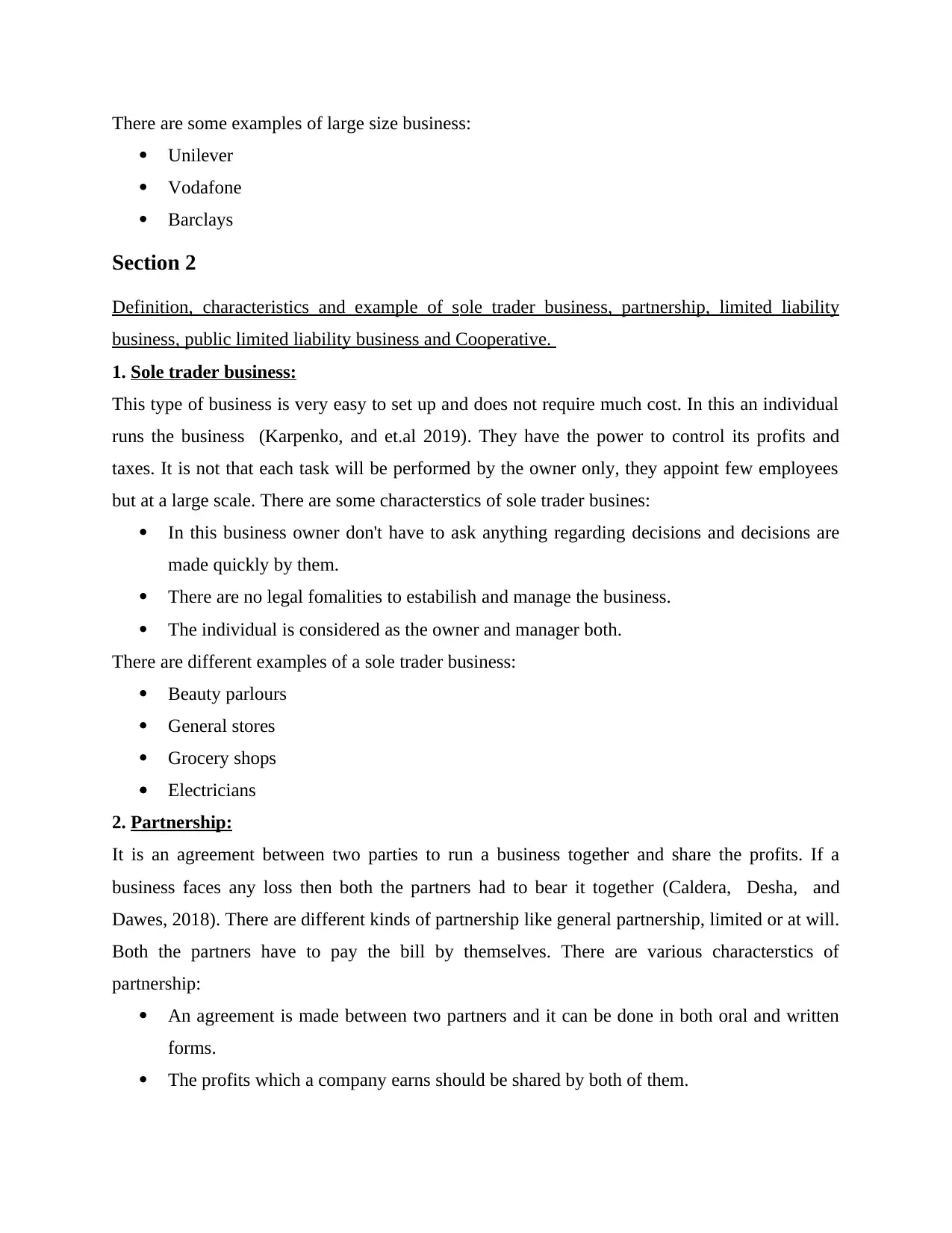
There are some examples of large size business:
Unilever
Vodafone
Barclays
Section 2
Definition, characteristics and example of sole trader business, partnership, limited liability
business, public limited liability business and Cooperative.
1. Sole trader business:
This type of business is very easy to set up and does not require much cost. In this an individual
runs the business (Karpenko, and et.al 2019). They have the power to control its profits and
taxes. It is not that each task will be performed by the owner only, they appoint few employees
but at a large scale. There are some characterstics of sole trader busines:
In this business owner don't have to ask anything regarding decisions and decisions are
made quickly by them.
There are no legal fomalities to estabilish and manage the business.
The individual is considered as the owner and manager both.
There are different examples of a sole trader business:
Beauty parlours
General stores
Grocery shops
Electricians
2. Partnership:
It is an agreement between two parties to run a business together and share the profits. If a
business faces any loss then both the partners had to bear it together (Caldera, Desha, and
Dawes, 2018). There are different kinds of partnership like general partnership, limited or at will.
Both the partners have to pay the bill by themselves. There are various characterstics of
partnership:
An agreement is made between two partners and it can be done in both oral and written
forms.
The profits which a company earns should be shared by both of them.
Unilever
Vodafone
Barclays
Section 2
Definition, characteristics and example of sole trader business, partnership, limited liability
business, public limited liability business and Cooperative.
1. Sole trader business:
This type of business is very easy to set up and does not require much cost. In this an individual
runs the business (Karpenko, and et.al 2019). They have the power to control its profits and
taxes. It is not that each task will be performed by the owner only, they appoint few employees
but at a large scale. There are some characterstics of sole trader busines:
In this business owner don't have to ask anything regarding decisions and decisions are
made quickly by them.
There are no legal fomalities to estabilish and manage the business.
The individual is considered as the owner and manager both.
There are different examples of a sole trader business:
Beauty parlours
General stores
Grocery shops
Electricians
2. Partnership:
It is an agreement between two parties to run a business together and share the profits. If a
business faces any loss then both the partners had to bear it together (Caldera, Desha, and
Dawes, 2018). There are different kinds of partnership like general partnership, limited or at will.
Both the partners have to pay the bill by themselves. There are various characterstics of
partnership:
An agreement is made between two partners and it can be done in both oral and written
forms.
The profits which a company earns should be shared by both of them.
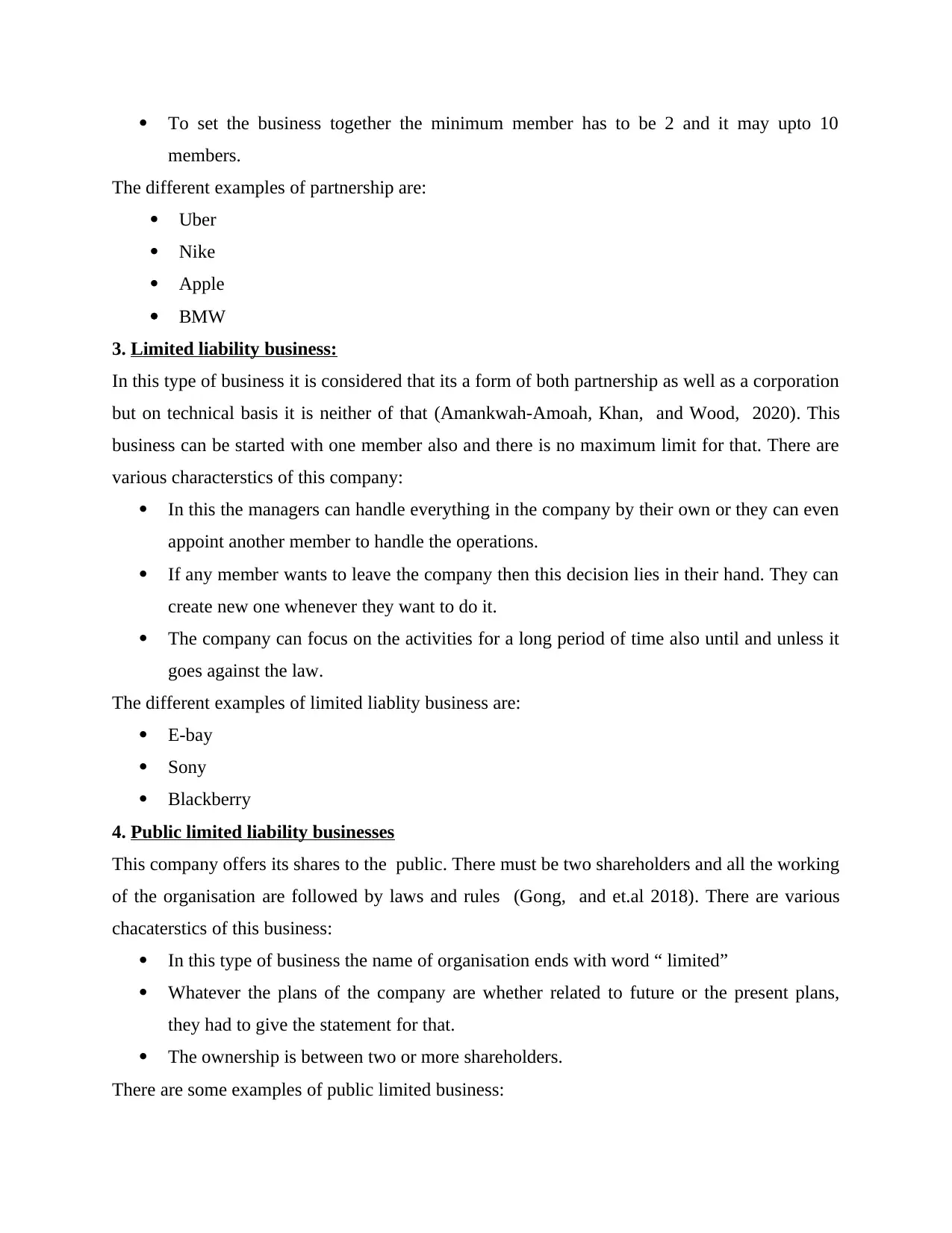
To set the business together the minimum member has to be 2 and it may upto 10
members.
The different examples of partnership are:
Uber
Nike
Apple
BMW
3. Limited liability business:
In this type of business it is considered that its a form of both partnership as well as a corporation
but on technical basis it is neither of that (Amankwah-Amoah, Khan, and Wood, 2020). This
business can be started with one member also and there is no maximum limit for that. There are
various characterstics of this company:
In this the managers can handle everything in the company by their own or they can even
appoint another member to handle the operations.
If any member wants to leave the company then this decision lies in their hand. They can
create new one whenever they want to do it.
The company can focus on the activities for a long period of time also until and unless it
goes against the law.
The different examples of limited liablity business are:
E-bay
Sony
Blackberry
4. Public limited liability businesses
This company offers its shares to the public. There must be two shareholders and all the working
of the organisation are followed by laws and rules (Gong, and et.al 2018). There are various
chacaterstics of this business:
In this type of business the name of organisation ends with word “ limited”
Whatever the plans of the company are whether related to future or the present plans,
they had to give the statement for that.
The ownership is between two or more shareholders.
There are some examples of public limited business:
members.
The different examples of partnership are:
Uber
Nike
Apple
BMW
3. Limited liability business:
In this type of business it is considered that its a form of both partnership as well as a corporation
but on technical basis it is neither of that (Amankwah-Amoah, Khan, and Wood, 2020). This
business can be started with one member also and there is no maximum limit for that. There are
various characterstics of this company:
In this the managers can handle everything in the company by their own or they can even
appoint another member to handle the operations.
If any member wants to leave the company then this decision lies in their hand. They can
create new one whenever they want to do it.
The company can focus on the activities for a long period of time also until and unless it
goes against the law.
The different examples of limited liablity business are:
E-bay
Sony
Blackberry
4. Public limited liability businesses
This company offers its shares to the public. There must be two shareholders and all the working
of the organisation are followed by laws and rules (Gong, and et.al 2018). There are various
chacaterstics of this business:
In this type of business the name of organisation ends with word “ limited”
Whatever the plans of the company are whether related to future or the present plans,
they had to give the statement for that.
The ownership is between two or more shareholders.
There are some examples of public limited business:
⊘ This is a preview!⊘
Do you want full access?
Subscribe today to unlock all pages.

Trusted by 1+ million students worldwide
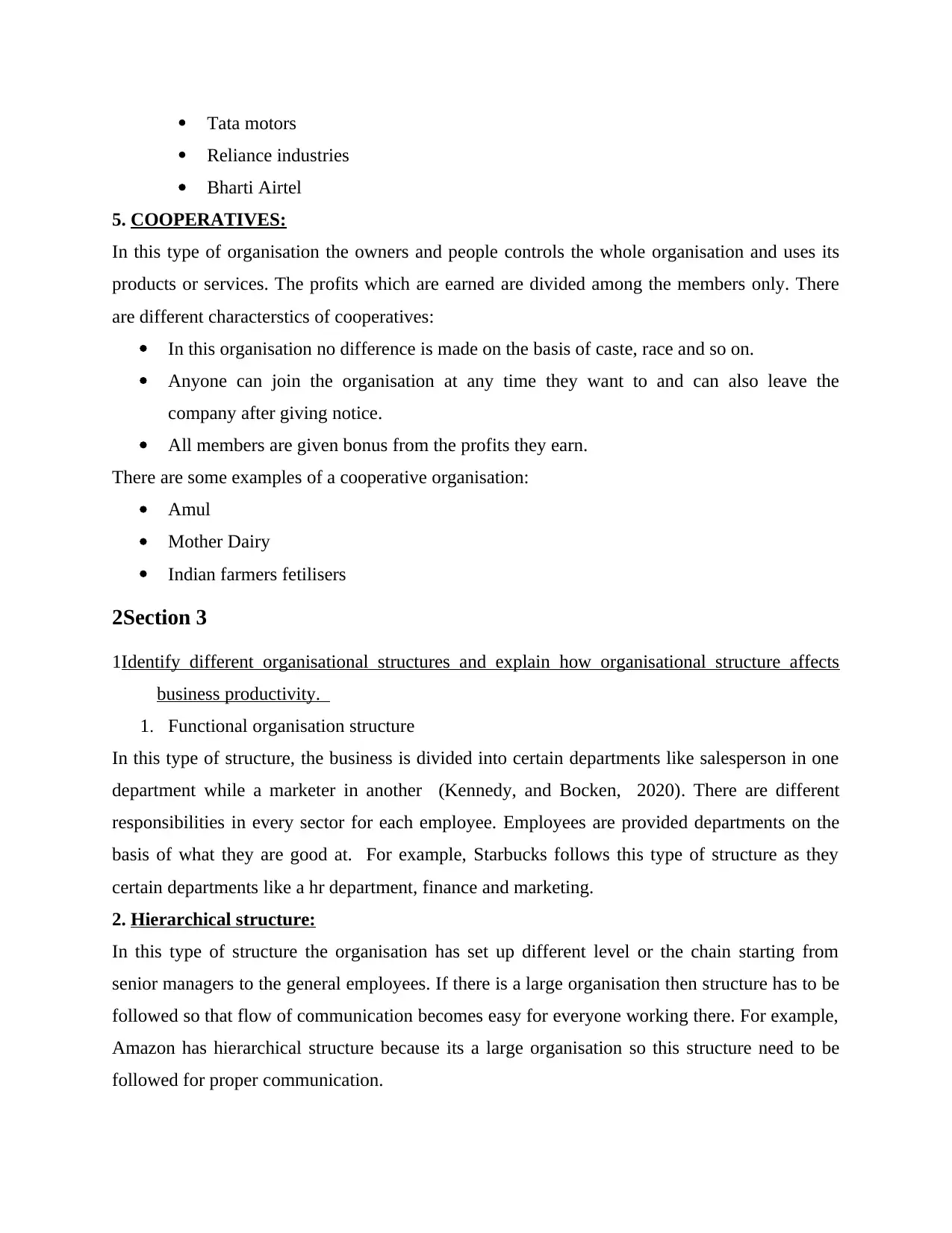
Tata motors
Reliance industries
Bharti Airtel
5. COOPERATIVES:
In this type of organisation the owners and people controls the whole organisation and uses its
products or services. The profits which are earned are divided among the members only. There
are different characterstics of cooperatives:
In this organisation no difference is made on the basis of caste, race and so on.
Anyone can join the organisation at any time they want to and can also leave the
company after giving notice.
All members are given bonus from the profits they earn.
There are some examples of a cooperative organisation:
Amul
Mother Dairy
Indian farmers fetilisers
2Section 3
1Identify different organisational structures and explain how organisational structure affects
business productivity.
1. Functional organisation structure
In this type of structure, the business is divided into certain departments like salesperson in one
department while a marketer in another (Kennedy, and Bocken, 2020). There are different
responsibilities in every sector for each employee. Employees are provided departments on the
basis of what they are good at. For example, Starbucks follows this type of structure as they
certain departments like a hr department, finance and marketing.
2. Hierarchical structure:
In this type of structure the organisation has set up different level or the chain starting from
senior managers to the general employees. If there is a large organisation then structure has to be
followed so that flow of communication becomes easy for everyone working there. For example,
Amazon has hierarchical structure because its a large organisation so this structure need to be
followed for proper communication.
Reliance industries
Bharti Airtel
5. COOPERATIVES:
In this type of organisation the owners and people controls the whole organisation and uses its
products or services. The profits which are earned are divided among the members only. There
are different characterstics of cooperatives:
In this organisation no difference is made on the basis of caste, race and so on.
Anyone can join the organisation at any time they want to and can also leave the
company after giving notice.
All members are given bonus from the profits they earn.
There are some examples of a cooperative organisation:
Amul
Mother Dairy
Indian farmers fetilisers
2Section 3
1Identify different organisational structures and explain how organisational structure affects
business productivity.
1. Functional organisation structure
In this type of structure, the business is divided into certain departments like salesperson in one
department while a marketer in another (Kennedy, and Bocken, 2020). There are different
responsibilities in every sector for each employee. Employees are provided departments on the
basis of what they are good at. For example, Starbucks follows this type of structure as they
certain departments like a hr department, finance and marketing.
2. Hierarchical structure:
In this type of structure the organisation has set up different level or the chain starting from
senior managers to the general employees. If there is a large organisation then structure has to be
followed so that flow of communication becomes easy for everyone working there. For example,
Amazon has hierarchical structure because its a large organisation so this structure need to be
followed for proper communication.
Paraphrase This Document
Need a fresh take? Get an instant paraphrase of this document with our AI Paraphraser
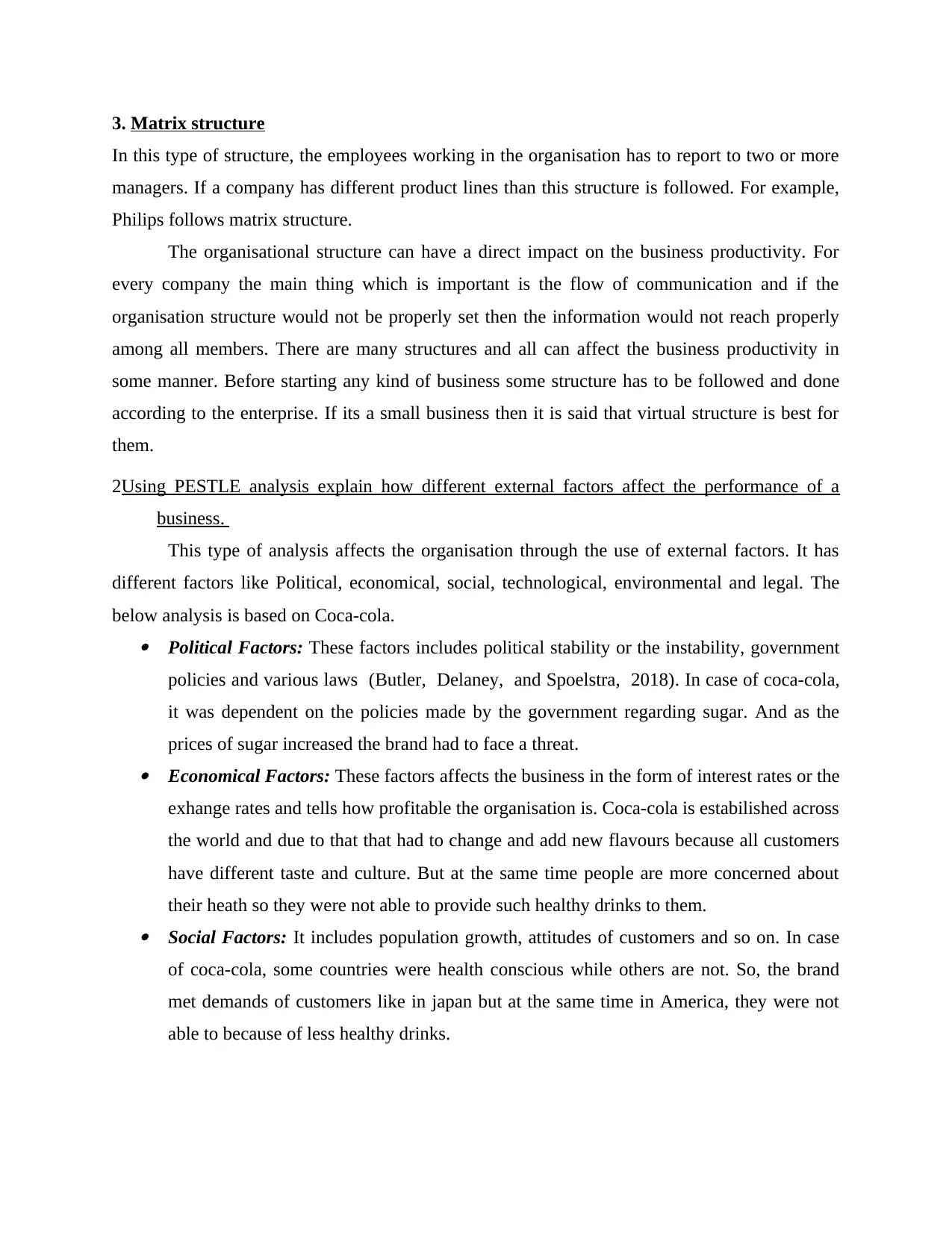
3. Matrix structure
In this type of structure, the employees working in the organisation has to report to two or more
managers. If a company has different product lines than this structure is followed. For example,
Philips follows matrix structure.
The organisational structure can have a direct impact on the business productivity. For
every company the main thing which is important is the flow of communication and if the
organisation structure would not be properly set then the information would not reach properly
among all members. There are many structures and all can affect the business productivity in
some manner. Before starting any kind of business some structure has to be followed and done
according to the enterprise. If its a small business then it is said that virtual structure is best for
them.
2Using PESTLE analysis explain how different external factors affect the performance of a
business.
This type of analysis affects the organisation through the use of external factors. It has
different factors like Political, economical, social, technological, environmental and legal. The
below analysis is based on Coca-cola. Political Factors: These factors includes political stability or the instability, government
policies and various laws (Butler, Delaney, and Spoelstra, 2018). In case of coca-cola,
it was dependent on the policies made by the government regarding sugar. And as the
prices of sugar increased the brand had to face a threat. Economical Factors: These factors affects the business in the form of interest rates or the
exhange rates and tells how profitable the organisation is. Coca-cola is estabilished across
the world and due to that that had to change and add new flavours because all customers
have different taste and culture. But at the same time people are more concerned about
their heath so they were not able to provide such healthy drinks to them. Social Factors: It includes population growth, attitudes of customers and so on. In case
of coca-cola, some countries were health conscious while others are not. So, the brand
met demands of customers like in japan but at the same time in America, they were not
able to because of less healthy drinks.
In this type of structure, the employees working in the organisation has to report to two or more
managers. If a company has different product lines than this structure is followed. For example,
Philips follows matrix structure.
The organisational structure can have a direct impact on the business productivity. For
every company the main thing which is important is the flow of communication and if the
organisation structure would not be properly set then the information would not reach properly
among all members. There are many structures and all can affect the business productivity in
some manner. Before starting any kind of business some structure has to be followed and done
according to the enterprise. If its a small business then it is said that virtual structure is best for
them.
2Using PESTLE analysis explain how different external factors affect the performance of a
business.
This type of analysis affects the organisation through the use of external factors. It has
different factors like Political, economical, social, technological, environmental and legal. The
below analysis is based on Coca-cola. Political Factors: These factors includes political stability or the instability, government
policies and various laws (Butler, Delaney, and Spoelstra, 2018). In case of coca-cola,
it was dependent on the policies made by the government regarding sugar. And as the
prices of sugar increased the brand had to face a threat. Economical Factors: These factors affects the business in the form of interest rates or the
exhange rates and tells how profitable the organisation is. Coca-cola is estabilished across
the world and due to that that had to change and add new flavours because all customers
have different taste and culture. But at the same time people are more concerned about
their heath so they were not able to provide such healthy drinks to them. Social Factors: It includes population growth, attitudes of customers and so on. In case
of coca-cola, some countries were health conscious while others are not. So, the brand
met demands of customers like in japan but at the same time in America, they were not
able to because of less healthy drinks.
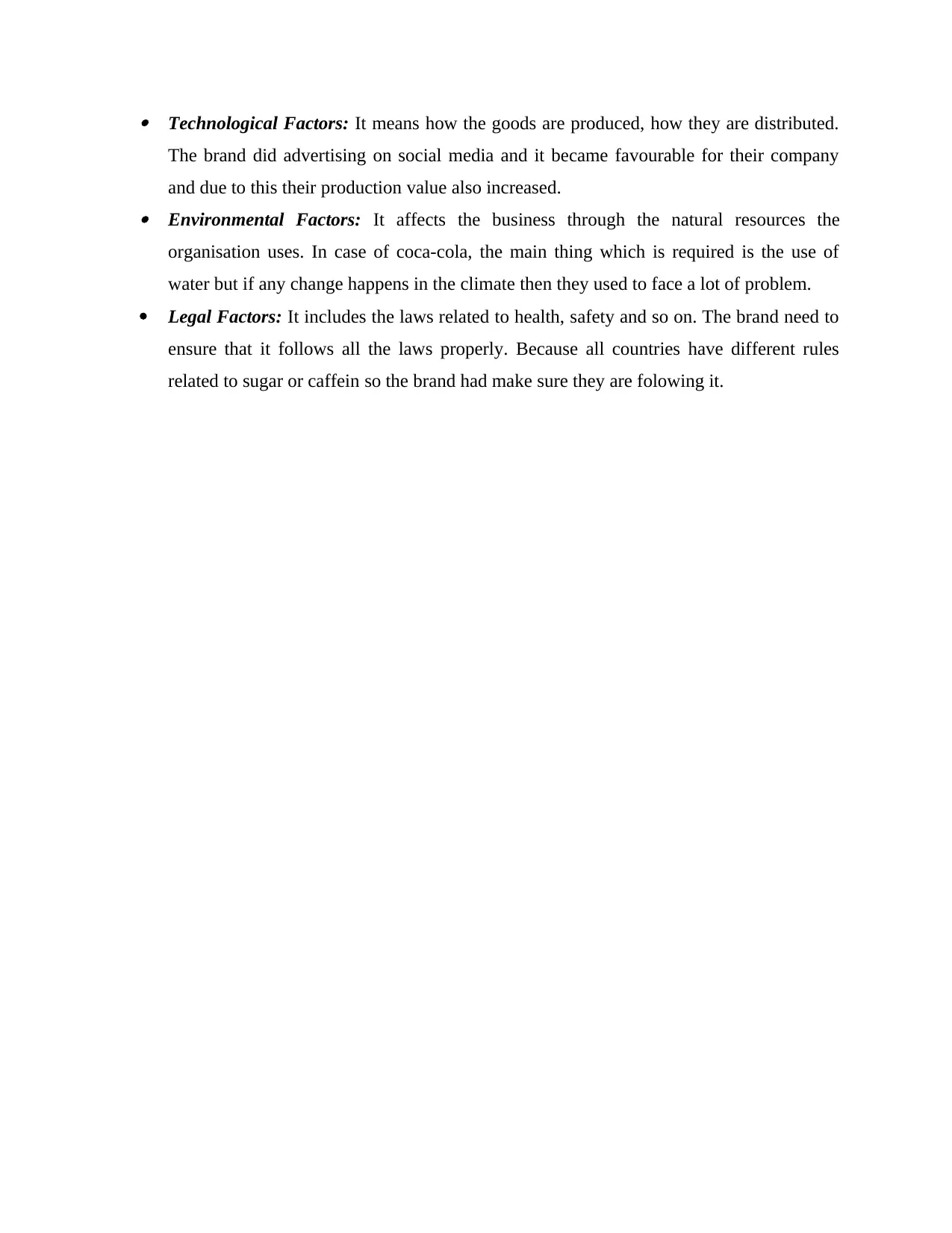
Technological Factors: It means how the goods are produced, how they are distributed.
The brand did advertising on social media and it became favourable for their company
and due to this their production value also increased. Environmental Factors: It affects the business through the natural resources the
organisation uses. In case of coca-cola, the main thing which is required is the use of
water but if any change happens in the climate then they used to face a lot of problem.
Legal Factors: It includes the laws related to health, safety and so on. The brand need to
ensure that it follows all the laws properly. Because all countries have different rules
related to sugar or caffein so the brand had make sure they are folowing it.
The brand did advertising on social media and it became favourable for their company
and due to this their production value also increased. Environmental Factors: It affects the business through the natural resources the
organisation uses. In case of coca-cola, the main thing which is required is the use of
water but if any change happens in the climate then they used to face a lot of problem.
Legal Factors: It includes the laws related to health, safety and so on. The brand need to
ensure that it follows all the laws properly. Because all countries have different rules
related to sugar or caffein so the brand had make sure they are folowing it.
⊘ This is a preview!⊘
Do you want full access?
Subscribe today to unlock all pages.

Trusted by 1+ million students worldwide
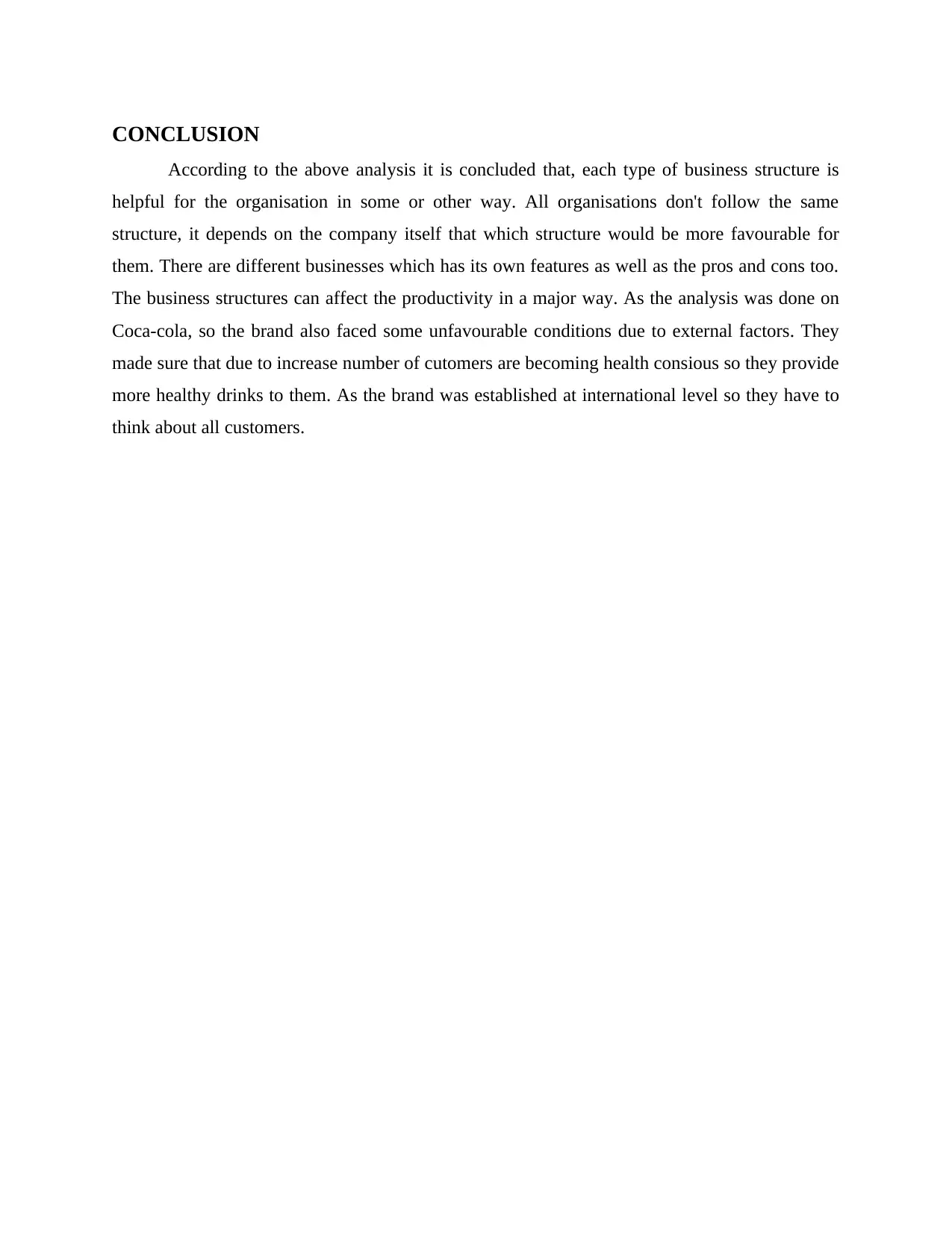
CONCLUSION
According to the above analysis it is concluded that, each type of business structure is
helpful for the organisation in some or other way. All organisations don't follow the same
structure, it depends on the company itself that which structure would be more favourable for
them. There are different businesses which has its own features as well as the pros and cons too.
The business structures can affect the productivity in a major way. As the analysis was done on
Coca-cola, so the brand also faced some unfavourable conditions due to external factors. They
made sure that due to increase number of cutomers are becoming health consious so they provide
more healthy drinks to them. As the brand was established at international level so they have to
think about all customers.
According to the above analysis it is concluded that, each type of business structure is
helpful for the organisation in some or other way. All organisations don't follow the same
structure, it depends on the company itself that which structure would be more favourable for
them. There are different businesses which has its own features as well as the pros and cons too.
The business structures can affect the productivity in a major way. As the analysis was done on
Coca-cola, so the brand also faced some unfavourable conditions due to external factors. They
made sure that due to increase number of cutomers are becoming health consious so they provide
more healthy drinks to them. As the brand was established at international level so they have to
think about all customers.
Paraphrase This Document
Need a fresh take? Get an instant paraphrase of this document with our AI Paraphraser
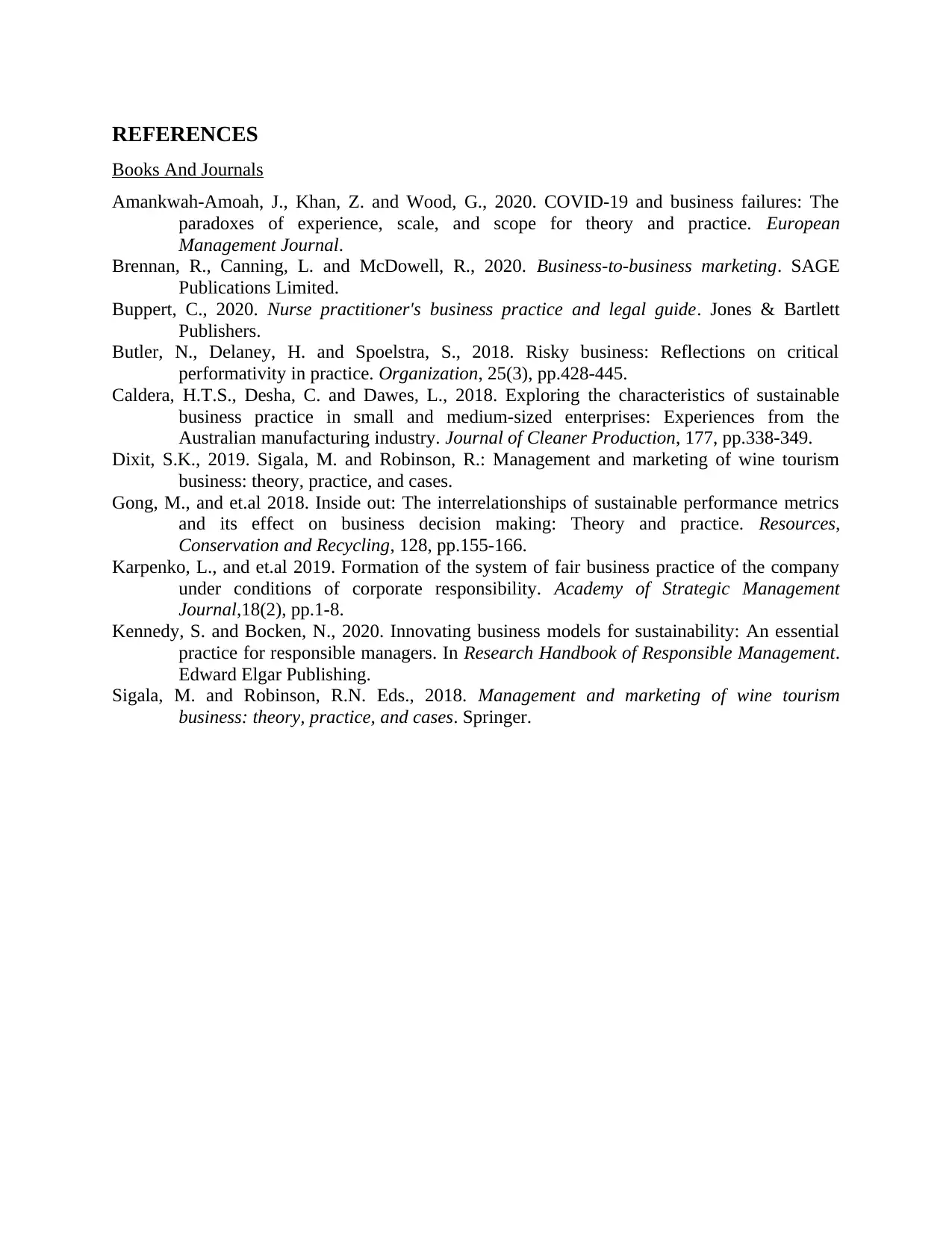
REFERENCES
Books And Journals
Amankwah-Amoah, J., Khan, Z. and Wood, G., 2020. COVID-19 and business failures: The
paradoxes of experience, scale, and scope for theory and practice. European
Management Journal.
Brennan, R., Canning, L. and McDowell, R., 2020. Business-to-business marketing. SAGE
Publications Limited.
Buppert, C., 2020. Nurse practitioner's business practice and legal guide. Jones & Bartlett
Publishers.
Butler, N., Delaney, H. and Spoelstra, S., 2018. Risky business: Reflections on critical
performativity in practice. Organization, 25(3), pp.428-445.
Caldera, H.T.S., Desha, C. and Dawes, L., 2018. Exploring the characteristics of sustainable
business practice in small and medium-sized enterprises: Experiences from the
Australian manufacturing industry. Journal of Cleaner Production, 177, pp.338-349.
Dixit, S.K., 2019. Sigala, M. and Robinson, R.: Management and marketing of wine tourism
business: theory, practice, and cases.
Gong, M., and et.al 2018. Inside out: The interrelationships of sustainable performance metrics
and its effect on business decision making: Theory and practice. Resources,
Conservation and Recycling, 128, pp.155-166.
Karpenko, L., and et.al 2019. Formation of the system of fair business practice of the company
under conditions of corporate responsibility. Academy of Strategic Management
Journal,18(2), pp.1-8.
Kennedy, S. and Bocken, N., 2020. Innovating business models for sustainability: An essential
practice for responsible managers. In Research Handbook of Responsible Management.
Edward Elgar Publishing.
Sigala, M. and Robinson, R.N. Eds., 2018. Management and marketing of wine tourism
business: theory, practice, and cases. Springer.
Books And Journals
Amankwah-Amoah, J., Khan, Z. and Wood, G., 2020. COVID-19 and business failures: The
paradoxes of experience, scale, and scope for theory and practice. European
Management Journal.
Brennan, R., Canning, L. and McDowell, R., 2020. Business-to-business marketing. SAGE
Publications Limited.
Buppert, C., 2020. Nurse practitioner's business practice and legal guide. Jones & Bartlett
Publishers.
Butler, N., Delaney, H. and Spoelstra, S., 2018. Risky business: Reflections on critical
performativity in practice. Organization, 25(3), pp.428-445.
Caldera, H.T.S., Desha, C. and Dawes, L., 2018. Exploring the characteristics of sustainable
business practice in small and medium-sized enterprises: Experiences from the
Australian manufacturing industry. Journal of Cleaner Production, 177, pp.338-349.
Dixit, S.K., 2019. Sigala, M. and Robinson, R.: Management and marketing of wine tourism
business: theory, practice, and cases.
Gong, M., and et.al 2018. Inside out: The interrelationships of sustainable performance metrics
and its effect on business decision making: Theory and practice. Resources,
Conservation and Recycling, 128, pp.155-166.
Karpenko, L., and et.al 2019. Formation of the system of fair business practice of the company
under conditions of corporate responsibility. Academy of Strategic Management
Journal,18(2), pp.1-8.
Kennedy, S. and Bocken, N., 2020. Innovating business models for sustainability: An essential
practice for responsible managers. In Research Handbook of Responsible Management.
Edward Elgar Publishing.
Sigala, M. and Robinson, R.N. Eds., 2018. Management and marketing of wine tourism
business: theory, practice, and cases. Springer.
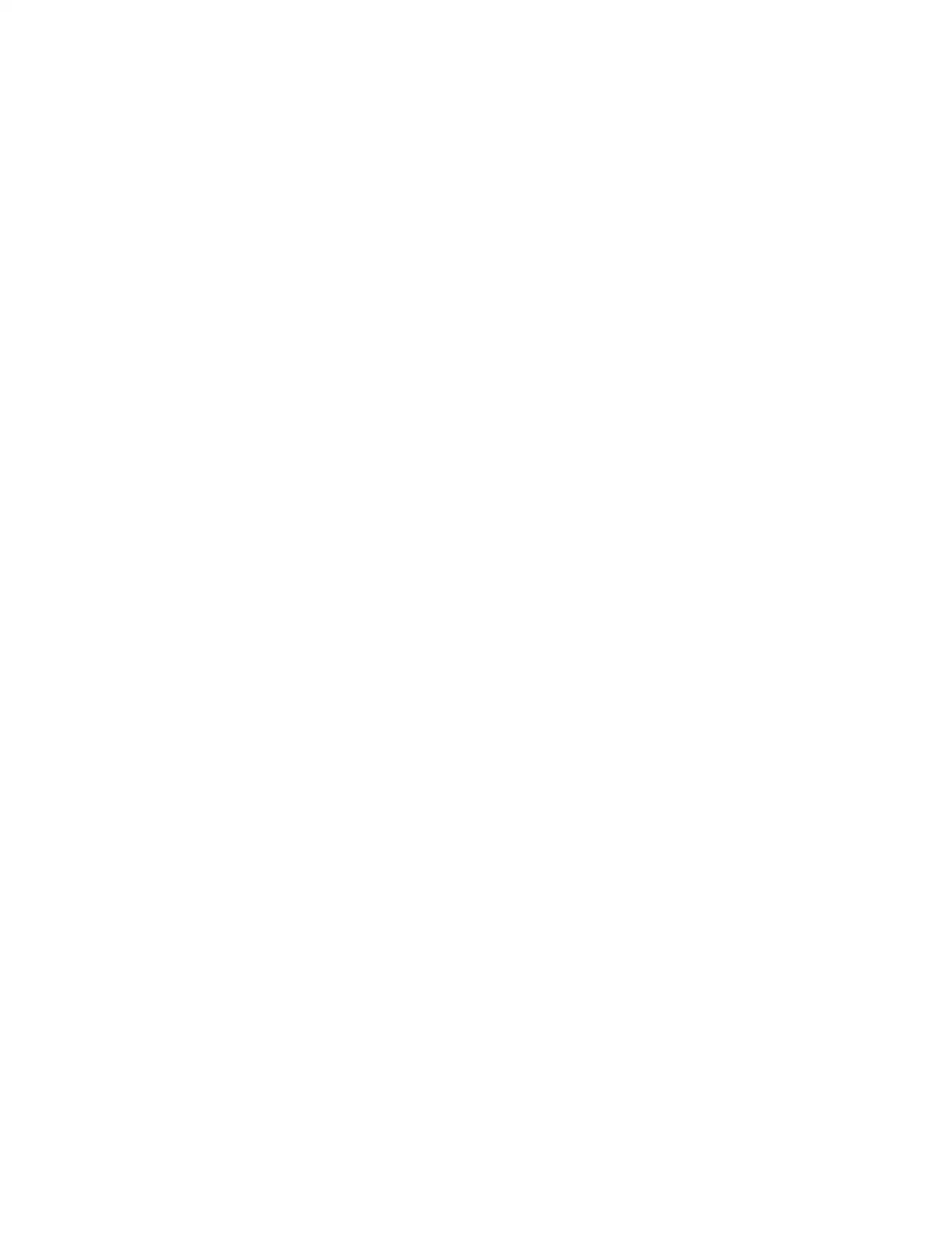
⊘ This is a preview!⊘
Do you want full access?
Subscribe today to unlock all pages.

Trusted by 1+ million students worldwide
1 out of 14
Related Documents
Your All-in-One AI-Powered Toolkit for Academic Success.
+13062052269
info@desklib.com
Available 24*7 on WhatsApp / Email
![[object Object]](/_next/static/media/star-bottom.7253800d.svg)
Unlock your academic potential
Copyright © 2020–2025 A2Z Services. All Rights Reserved. Developed and managed by ZUCOL.





